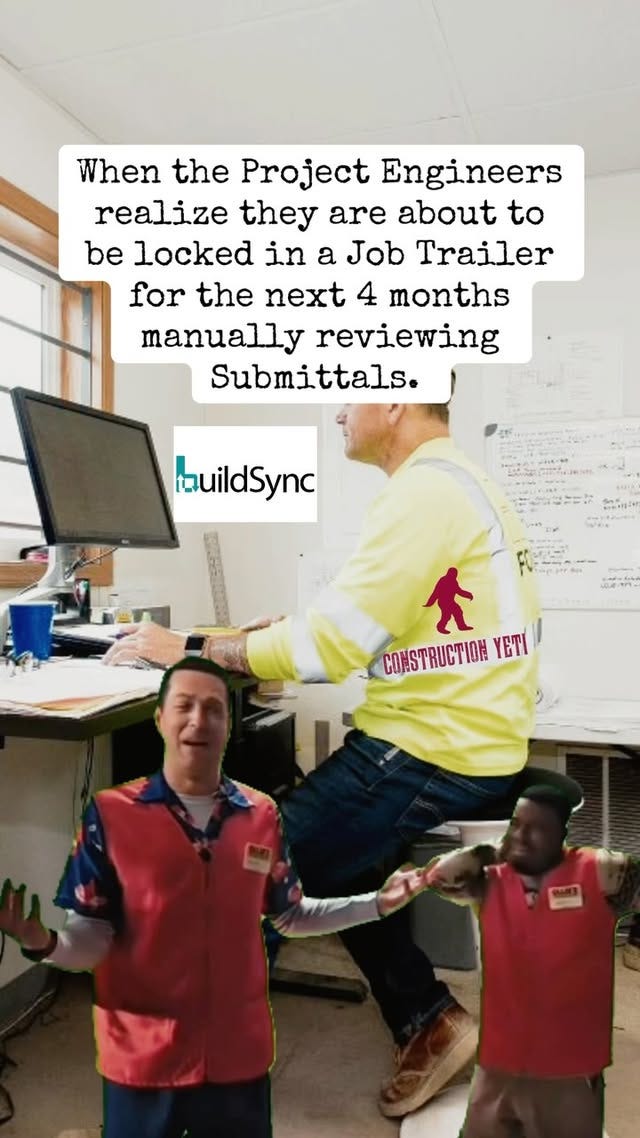Hey! Happy Sunday! Matt here.
Welcome to the Construction Curiosities newsletter!
I promised just a month of Procurement & Contracting. But there’s just too much fun to be had in these boring documents… So let’s keep it rolling.
This week, I enlisted the help of a Construction Contract Attorney to help define and clear up some of those nasty contract clauses that everyone hates.
If your response to RTFC is:
"I read it... But what's it all mean?"
You won’t want to miss this one.
Summary
This week we will look at:
One Guest Article: Confusing Construction Contract Clauses
Contech Corner: BuildSync Announcement
One Meme: I don’t know what he said…
Confusing Construction Contract Clauses
By: Theresa Golde | Special Counsel for The Schoenbaum Firm, theresa@schoenbaumfirm.com
This is the month of Procurement & Contracting, so I will continue the discussion Matt started on the General Conditions of the AIA. What are the General Conditions, and what are some important considerations? The AIA has various templates for a Construction Contract, depending on the type of contract the parties want for a project (e.g. A101-2017 - Standard Form of Agreement between Owner and Contractor where the basis of payment is a Stipulated Sum or A102-2017 - Standard Form of Agreement between Owner and Contractor where the basis of payment is the Cost of the Work Plus a Fee with a Guaranteed Maximum Price).
No matter what type of standard form template you use, you would also be attaching the General Conditions template that the AIA has created (A201-2017 - General Conditions of the Contract for Construction) (“General Conditions”). The standard form contract will direct the parties to the General Conditions template, and the General Conditions will be listed as part of the Contract Documents. The General Conditions include many of the legal stipulations around how the project will be legally handled and must be incorporated into the Construction Contract as an exhibit.
Make sure to read the entire Construction Contract, including the General Conditions and all other exhibits, because it’s important to know your rights throughout the project and how to handle potential issues. Here, I will specifically focus on the following key clauses in the General Conditions (this is a non-exhaustive list, so please understand there are many other key considerations not discussed):
Limitation of Liability
Indemnification
Dispute Resolution
Limitation of Liability Clause
It is what you would think…a limit on a party’s liability. There are some keys considerations in this clause (again, this is a non-exhaustive list of such considerations), which focus on what liability is being limited.
For example, the General Conditions include a mutual waiver of consequential damages, which means that this will be limiting the type of damages that parties can seek against one another if there is a dispute. With such a waiver, a party will not be able to seek consequential damages; the list of such consequential damages is included in the contract, but like all clauses, the parties can negotiate this language and try to narrow or broaden the list if they choose. Further information on the waiver of consequential damages can be found at the following link:
Parties can also negotiate further language to limit liability, which may include a max liability cap to limit the amount a party is liable as well as a clause for no personal liability. Such clauses are not in the General Conditions, so parties would need to negotiate this language.
Indemnification Clause
I know, this term sounds very legalese, but let me try to break it down:
Indemnification rights in a contract allow a party (the “Indemnified Party”) to seek damages against another party (the “Indemnifying Party”) if there was a third-party lawsuit and it was determined that the Indemnifying Party was at fault or partly at fault (depending on how your indemnification clause is written).
The Indemnified Party might be able to utilize the indemnification clause to pay for costs and damages incurred from the third-party lawsuit, which resulted from something the Indemnifying Party did or failed to do. An indemnification clause typically opens with either “shall indemnify, defend, and hold harmless . . .” or “shall indemnify and hold harmless . . .”
In Texas, the duty to indemnify is different than the duty to defend. If the word “defend” is in the indemnity, then it might mean that if there is a third-party lawsuit that involves something the Indemnifying Party did or failed to do, the Indemnifying Party may have to incur the costs to hire an attorney and defend that lawsuit in addition to the damages that will need to be paid based on the results of such lawsuit and what falls under the duty to indemnify.
If the word “defend” is not included, the Indemnified Party might need to pay for an attorney to defend the third-party lawsuit because the duty to indemnify is generally determined after such third-party lawsuit is resolved; the Indemnified Party may be able to subsequently seek reimbursement for such fees based on the results of the third-party lawsuit and the parties’ rights in the indemnification clause.
Dispute resolution
This is a lengthy part of the General Conditions and for good reason, as it goes through the process the parties must adhere to if there is a dispute. The General Conditions create the right first step, which is to require mediation as a condition precedent to binding dispute resolution. While mediation may occur at any time the parties mutually agree to mediate, contractually requiring pre-suit mediation as we see in the General Conditions may help parties resolve a dispute without having to arbitrate or litigate.
What is mediation vs. arbitration vs. litigation?
Mediation is a private process whereby the parties hire a mediator (a neutral third party) to help the parties come together to talk through a dispute. The General Conditions state that the mediation shall be administered by the American Arbitration Association (“AAA”) in accordance with its Construction Industry Mediation Procedures in effect on the date of the contract, unless the parties mutually agree otherwise. If the parties come to an agreement in pre-suit mediation, they will enter into a settlement agreement (i.e. a binding contract) and the dispute will be resolved without having to arbitrate or litigate. I’m a big fan of pre-suit mediation and trying to settle matters from the outset! Here is a link with further information on mediation from the AAA:
If the parties are unable to come to an agreement with pre-suit mediation, then they can proceed to arbitration or litigation depending on the dispute resolution process the parties chose in the contract. Arbitration is a private forum for the parties to go through their dispute. The parties may mutually decide on the arbitrator(s) to handle the dispute depending on the language negotiated in the contract. The General Conditions state that arbitration shall be administered by the AAA in accordance with its Construction Industry Arbitration Rules that are in effect on the date of the contract, unless the parties mutually agree otherwise. Here is a link with further information on arbitration from the AAA:
https://www.adr.org/Arbitration
Litigation, on the other hand, is not private. This is the public forum to go through the parties’ dispute and is handled by the courts. There are bench trials (where the judge makes the ruling) and jury trials (where the jury makes the ruling). The parties may have negotiated a jury waiver in the contract, which means that if the parties litigate their dispute, the parties will have a bench trial, so a judge rather than a jury will make the decision. In litigation, while the parties may have a role in selecting a jury, the judge(s) handling a case is based on rules in the jurisdiction of the dispute and various other factors. Here is an article providing further context on the distinction between arbitration and litigation:
https://legal.thomsonreuters.com/blog/arbitration-vs-litigation-the-differences/
The dispute resolution process that is best for a party needs to be determined on a case-by-case basis. There is no right or wrong answer.
All Construction Contact clauses, including the clauses discussed here, need to be carefully drafted to ensure the parties’ rights are protected. Parties should seek their own legal counsel to talk through their options and assist them in negotiations of the contract language.
DISCLAIMER: The purpose of this blog post is to provide general information on some key clauses to consider in the General Conditions of a Construction Contract. All content provided is for informational purposes only and is not considered legal advice. The following information was compiled as of June 5, 2025. Some aspects of the following information may change as legal updates are always on the horizon. The transmission of information from the resources provided does not establish an attorney-client relationship with the viewer. The viewer should not rely on the information contained herein for any specific matter or fact pattern without consultation with an attorney. The viewer is advised to check the date of this information and to seek subsequent updates. Additionally, the information is non-exhaustive, and viewers of this information must conduct their own research and seek their own legal advice regarding further information with all matters discussed herein.
ConTech Corner
Over the last few years, I’ve demo’d a bunch of ConTech softwares.
And a bunch of those either don’t solve real construction industry problems, don’t actually do anything for the user, or move the needle so little it’s not worth the effort.
Enter BuildSync.ai
Have you ever spent an entire week (or weeks) locked away in an office doing Submittal Spec compliance reviews…
…flipping page by page of product cut sheets along with the Spec book like you are in the World’s most boring version of Where’s Waldo.
Only to go cross eyed, miss a few things, and have your submittals returned Revise and Resubmit....
Yeah… Same.
Man, I hate submittals. 😫
When Tom Port first reached out to show me what they do, I think I (un)intentionally blew him off for over a month. It was another one of those too good to be true “AI” promises.
When I finally chatted with him, he promised it:
✅ Auto-reviews your submittals via AI & Human-in-the-Loop QA Engineers
✅ Would flag everything that’s missing
✅ Saved HOURS/ DAYS on submittal processing and review.
✅ And then less than 5% getting rejected (industry average is 35%)
He didn’t try to sell me. He just gave me a free trial and told me to throw in my toughest ones and see what I thought.
So I did. And I was blown away. In just 3 trial submittals I was an immediate fan.
Many of you know my other passion is being a resource for the Next Generation coming into the industry. You’ve seen everyone post the stats so I won’t bore you but you know more people are retiring then joining the industry across all trades, as well as in Construction Management roles.
And here’s the truth no one wants to say out loud:
The next generation isn’t going to want to join this industry if they’ve spent college using ChatGPT to automate research, check their writing, and summarize 300-page textbooks…
...only to get dropped into an entry-level PE role where they’re told to manually cross-reference 37 spec sections against 112 submittals. By hand.
We’ve got to evolve. And BuildSync is one of the few tools I’ve seen that actually understands why.
So I’m pumped to officially say I’m joining BuildSync as an Advisor.
I’ll be helping them get their messaging out and helping ensure the product continues to move the needle for its users.
Because the goal isn’t to “digitize the submittal process.” The goal is to stop wasting your time on admin work so you can focus on being proactive.
Let’s Build Smarter. Let’s Build Synced.
TLDR:
👀 Want to check it out?
The 20% Construction Yeti discount from our LinkedIn Live is here to stay. 🕺
Book a personal demo through the special link to lock it in:
BuildSync x Construction Yeti Special Demo (and Discount) Link
Thank me later. 😉
One (more) Meme
So now you can send this newsletter to someone who doesn’t know what they are saying when they start talking in contract clauses.
Construction Curiosities is a reader-supported Newsletter. Please consider upgrading your subscription to help support the work we are doing. With your support, we have more big things planned and in the works.













